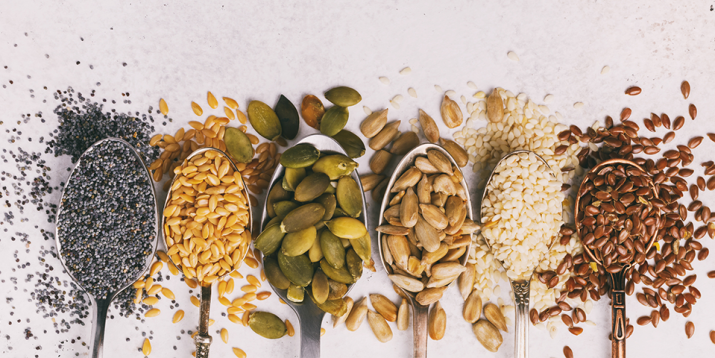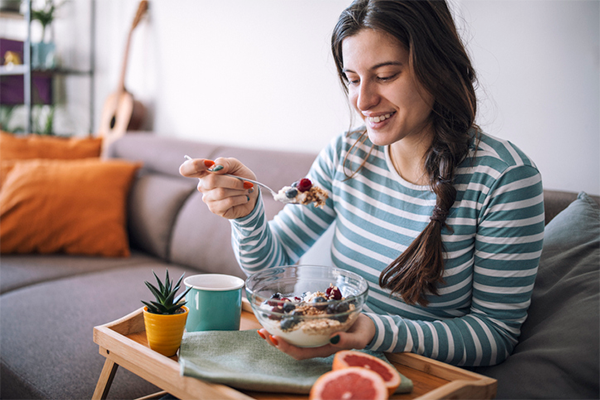Grow a More Balanced Menstrual Cycle with Seed Cycling

Seed cycling is a holistic, nutrition-based approach that some evidence suggests may help support a normal balance of the female hormones estrogen and progesterone.
Though you might see influencers posting about the “trend” of seed cycling, this practice has a long history of traditional use in naturopathic medicine and other holistic modalities.
But, does seed cycling work? And which seeds are best?
Let’s get to the root of your questions about seed cycling.
What Is Seed Cycling?

“Seed cycling is eating select seeds during different phases of the menstrual cycle in an effort to balance hormones,” says Tina Marinaccio, MS, RD, who offers nutrition counseling and cooking classes in the greater New York City area.
The menstrual cycle has two phases:
- Follicular phase: Day one of your period through ovulation, when estrogen levels are higher, and progesterone levels are lower.
- Luteal phase: Ovulation to day one of your next period, when estrogen levels are lower and progesterone levels are higher.
Different seeds are traditionally consumed daily during each phase:
- Follicular phase: one tablespoon each of flaxseed and pumpkin seeds
- Luteal phase: one tablespoon each of sunflower seeds and sesame seeds
What Does Seed Cycling Do?
Seed cycling uses nutrition to help support the normal balance of hormones that play a role in fertility and conditions, including:*
- PMS
- polycystic ovarian syndrome
- uterine fibroids
- irregular periods
- period pain
*It’s always best to consult with your physician before starting any new nutrition program — especially if you’re experiencing any of the above symptoms and conditions.
“The substances consumed in the first half of the month are more estrogen-promoting,” explains says Dr. Heather Tynan, ND. “Those consumed in the second half are more progesterone-promoting. They support the natural waves of hormonal waxing and waning in the normal menstrual cycle, and ultimately proper estrogen-to-progesterone ratios.”
Ideally, seed cycling should start on day one of your period.
By eating certain seeds high in specific nutrients, you “promote appropriate hormone ratios during that particular phase,” says Tynan.
She uses seed cycling with patients to address a variety of gynecological concerns. She says it can take three months or more to see results.
Marinaccio says that advocates “purport that consuming omega-3 fatty acids and lignans found in the seeds in phase one support healthy estrogen levels.”
In the luteal phase, it’s the omega-6 fatty acids and lignans in the seeds believed to help optimize hormone balance.
The seeds are also sources of phytoestrogens, or components in plants that mimic the estrogen your body makes, explains Tynan.
Phytoestrogens fill in for your estrogen when levels are low and compete with it when they’re too high.
Does Seed Cycling Work?

“Seed cycling [may help] remedy irregular menstrual cycles and female reproductive-related symptoms for many women,” Tynan says. “Of course, it’s not the single answer for everyone.”
Seed cycling “pushes the balance of hormones in the right direction,” she says, but the ultimate question is, “What caused the imbalance?”
If a person has another condition or a lifestyle concern, “seed cycling is unlikely to be the standalone solution,” she says.
“Right now, there is not a lot of evidence to support using seed cycling to balance hormones during reproductive age,” says Marinaccio.
She added that there is “some evidence” that the nutrients in seeds can help symptoms of menopause, such as hot flashes. “More research is needed to explore the potential benefits of seed cycling for hormone balance.”
Do You Have to Use Ground Seeds for Seed Cycling?
While you can simply snack on pumpkin and sunflower seeds (as you would puffed water lily seeds), says Tynan, your body will absorb sesame and especially flax seeds better if they are ground.
To preserve their healthy fats, store all seeds in the fridge or freezer, and grind a small amount at a time.
One tasty, simple way to use your seeds is to grind them, then mix with your favorite seasoning blend, nutritional yeast, salt, and pepper.
Sprinkle the mixture on vegetables, stir into soup, or mix with hummus or another dip.
Should I Try Seed Cycling for Hormone Balancing?

“Seed cycling is often an easy, inexpensive, safe place to start for women who are trying to get their reproductive systems and cycles back on track,” says Tynan, adding that is “provided no other health issue is present that demands more immediate medical intervention.”
Marinaccio adds that, “seeds are high in minerals, fiber, healthy fats, and offer many benefits (that the whole family can enjoy).”
You should always consult your physician to see if this approach may be right for you or to determine if you have a more serious issue.
